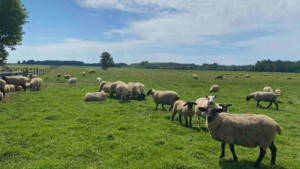
Maria Mederos, Satbir Singh, Kailee Tones, Ankit Banerjee
Ontario's population is projected to increase between 19.9 and 35.8 percent over the next 24 years and will only make the growing housing shortage even worse. The solution is obvious - we need to build more. But more construction has a hidden cost, with ongoing urbanization eating into an essential resource, Ontario's farmlands.
"It is important for people to have places to live. But we need to have things to eat." - Hershil Sheth
The Ontario Farmland Trust (OFT), founded in 2004, is an organization that works to protect farmlands in Ontario. The goal is to not only maintain our natural lands but also to lower Ontario's natural gas emissions, one farm at a time. Hershil Sheth is the Policy Planner and Coordinator at OFT and started working there last year to help achieve this goal.
Why are organizations like OFT necessary?

Ontario is losing 175 acres of farmland every day to urbanization. To put that in context, it is the equivalent of 175 football fields! That's a 2.8 million-acre loss over the past 35 years. While the potential food shortage is selfishly our biggest concern, the environmental impact is far more severe if this disturbing trend continues. It's also harming existing ecosystems and putting species that are already vulnerable at risk of being endangered. The Eastern Wood-Pewee, the Monarch Butterfly, the Eastern Meadowlark and the Barn Swallow are just a few of the insects at risk, along with the endangered Butternut tree.
Is there a solution to the housing problem?
Ontario will understandably not stop developing land that is not protected. With a growing population, people do need somewhere to live. Though, there is a solution to building smarter. As Sheth suggests, urban designers need to look at building upwards rather than outwards to stop the continuous take over of prime agricultural lands.
We are already seeing this in action in some ways, with development proposals for the Greater Golden Horseshoe recommending 50% intensification rates in areas like Hamilton, Durham, York Region, Peel and Halton. If the policy is approved, half of all new housing will be built in existing built-up areas, which means that 75-85% of all housing in built-up areas will be apartments over the next 30 years. But a proposed development plan isn't nearly enough as Ontario continues to lose farmland at an alarming rate.
What is the Ontario Farmlands Trust doing?
The negative impact that tearing up farmlands has on the environment is never-ending. There are solutions, though, and it starts with small organizations like OFT. As Melissa Schneider, the Communications and Development Manager at OFT, says, "it's never been as prevalent as it has been right now, the need to save agricultural land."
Since the Ontario Farmland Trust was first established, it has helped protect 2300 acres of farmland. That's 20 family farms that will have permanent protection from urban developments. Among the 20 is the Farrow Family Farms.

Found on the shores of Lake Huron, the Farrow Family Farms stretches over 620 acres of farmland, with an operation that produces sheep, cattle, crops, honey, potatoes, hay, and more. After noticing increasing development that resulted in estate homes and golf courses reaching only half a kilometre away from the farm's borders, the Farrow family knew it was time for action. The Farmland Trust helped the family sign up for the Farmland Easement Agreement, which ensured that not only would the farm be protected now, but for many generations to come.
The Farrow Family farm has irreplaceable agricultural soils with wetlands, streams, meadows and riparian forests. It provides crucial ecological necessities like water filtration and erosion control that benefit both local communities and wildlife. Not having these 620 acres would have meant species loss, loss of water resources, and a crucial food source.
Hershil, Melissa, and the rest of the team at the Ontario Farmland Trust aim to bring more awareness to the issue and the importance of farmers getting their land protected. The organization holds an annual Farmland Forum that brings planners, farmers, researchers, politicians, policy planners, and conservers together. But these are just the small, initial steps in what is likely to be a very long journey.

Be the first to comment